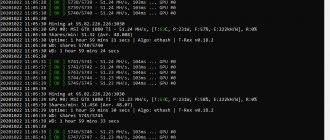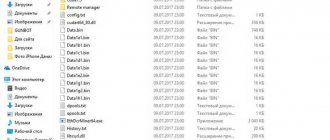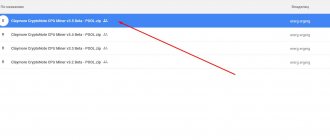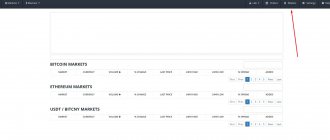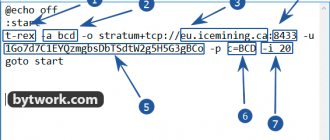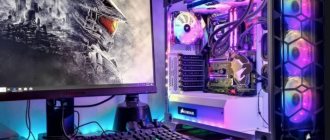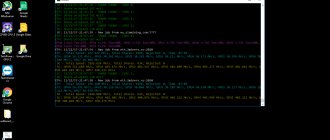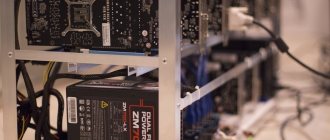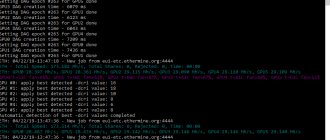Anton Goloston 11/29/2020
A huge number of users who mine cryptocurrencies in an amateur format have no idea that generation with the same equipment can be carried out using several, in our case, two algorithms simultaneously.
Information about the entry into the market of equipment that mines several coins on one chip is constantly circulating on the network.
But information about the Claymore Dual miner program spreads much more slowly, since not all network participants work with deep and complex software settings for crypto mining.
In this review we will correct this situation.
Download Claymore
The first thing you need to do is download Claymore's. For those with any technical experience, this should be the easiest part of the process. Download the latest version. You will need to unzip this file somewhere on your computer.
Note : If you don't have a modern graphics card with the appropriate amount of RAM, you may want to stop reading. Claymore only works with higher-end cards like the RX 470, 480, or 580 with at least 2GB of RAM (and a few others), and top-of-the-line cards made with Nvidia hardware.
How does the program work?
From English the word Claymore is translated as an old broadsword. The utility has been produced since 2014. The short answer to Claymore’s question, what is it, is that it is a tool for generating cryptocurrency blocks on a graphics accelerator.
What algorithms does the program support?
The program is still relevant for mining Ethereum on Nvidia cards with a video memory capacity of 6 GB or more, and for mining coins of the Ethash algorithm (except ETH/ETC) on AMD graphics adapters with a video memory capacity of 4/8 GB. After the Ethereum Classic cryptocurrency switched to the modified Etchash mining algorithm on November 29, 2022, it cannot be mined on Claymore. This utility is not suitable for mining large ether on any AMD cards. It's all over in era 384 and the developer has no contact with the community. In general, the developer wrote several times that he wanted to quit writing miners. In my opinion, even that 15.0 is the last version, and there will be no more. Don’t wait for his miner updates, go straight to TRM or Phoenix.”
In addition to Claymore dual miner, variants of claymore mining software have been created using the Zikesh and Kryptonite algorithms. But, in 2022, these miners are no longer relevant, as is double mining. But the latest versions of the program have received several very useful options.
Trusted sources where you can download the latest release of the Claymore miner are the Bitcointalk (https://bitcointalk.org/index.php?topic=1433925.0) and the GitHub . Versions of Claymore dual from other "official sites" may contain malicious code.
Yandex browser protection and antivirus classify Claymore as an unsafe file. If you downloaded this utility from the Bitcointalk forum, (MEGA https://mega.nz/#F!O4YA2JgD!n2b4iSHQDruEsYUvTQP5_w) then simply ignore these signals. But it’s still not worth downloading anywhere; it’s almost impossible to distinguish a valid miner from an infected one.
miningclub.info forum, popular among owners of gpu rigs , there is a special section called the sob room, where you can read the complaints of frivolous miners downloading software anywhere. If you do not want to become a regular in the “crying room,” download mining utilities only from reliable services.
Features of the latest v15.0 release
- ⋅ Thanks to the new program code, the ETH mining hashrate has been increased , the developer has now abandoned unreliable and outdated resources, can send tasks faster for graphics adapters, has optimized graphics core code and OpenCL.
- ⋅ Compatible with red and green GPUs, and combination rigs.
- ⋅ Works with any variant of Stratum on ether, uses direct proxy connections to services supporting eth-proxy, miner-proxy, or qtminer.
- ⋅ Works on the stratum for Keccak, Blake2s, Lbry, Pascal.
- ⋅ Has an emergency reboot .
- ⋅ Allows remote monitoring and management of rig settings.
- ⋅ Displays complete data on the performance of video cards to the terminal.
- ⋅ Allows selective launch of the GPU, regulates the hashrate and temperature values of the mining rig.
- ⋅ — y puts the card into computing mode and turns off CrossFire. The option is available only for red ones in Windows OS.
- ⋅ — showdiff shows the difficulty of mining in the current period. Write in the body file - showdiff 1 , and the highest difficulty of the mined ball will be displayed when you press the letter s on the keyboard.
- ⋅ — showpower shows the power of the GPU.
- ⋅ — driver option is responsible for installing and removing the driver necessary for modifying belts. And also for activating the Windows test mode. This option works exclusively in Windows and can only be enabled as an administrator. Works with any drivers. You can use an unsigned driver only in test mode after disabling secure boot in the UEFI BIOS.
- ⋅ — driver install installs a signed driver.
- ⋅ — driver install_test installs an unsigned driver and activates the operating system test mode (requires a PC restart).
- ⋅ — driver uninstall removes the driver and deactivates the test mode. Applies only in the case of a separate operation with the driver; by default, the claymore works with a signed driver.
- ⋅ -strap (strap) applies specified memory timings to increase hashrate without flashing the card. Works only on Windows with AMD Blockchain drivers or 18.x or later drivers (most tests were done on 19.4.3 ) for AMD graphics cards, and any latest Nvidia drivers. Polaris, Vega and Nvidia 10xx cards are currently supported.
- ⋅ -sintensity is used to adjust the intensity of the load on greens if the -strap option is unstable on your cards.
- ⋅ - rxboost provides an extra boost for AMD Polaris cards and older AMD cards. The parameter - rxboost is available only for Windows.
Find a pool
Before you can properly set up Claymore, you need to decide on the Ethereum mining pool you are going to use.
But wait, you ask, what about solo mining where you can earn real money? Unless you've invested tens of thousands of dollars in your equipment, you probably don't want to deal with mine. Technically you can mine solo, but it's a bit more involved and you risk running your rig for weeks or months and possibly never creating any Ether.
Chances are, if you're reading this site, you need a pool. But which one should you join? We recommend Ethermine or Nanopool. Both are highly regarded in the community and have websites that are primarily in English.
So, you need to select a pool. For now, we recommend that you simply select the pool where the greatest power is concentrated:
| # | address | power,% | commission, % | approx. | min. pay |
| 1 | https://ethermine.org | 28,60 | 1 | PPLNS payouts (better) | 0.05 |
| 2 | https://www.sparkpool.com | 17.9 | 1 | Chinese interface | 0.05 |
| 3 | https://dwarfpool.com/eth | 15.0 | 1 | can be adjusted min. payout up to 0.05 | 1.01 |
| 4 | https://eth.nanopool.org | 13.3 | 1 | sometimes statistics lag behind | 0.2 |
| 5 | https://www.f2pool.com | 9% | 2.5 | registration required | 0.1 |
| 6 | https://ethereum.miningpoolhub.com | 8% | 0.9 | registration required | 0,0105 |
Peculiarities
This software is not the only one of its kind, since the topic is extremely popular among users.
Many companies and development groups market their creations.
In order not to take a lot of time to highlight the differences, we list the main features of the miner being disassembled:
- New multi-mining modes. The range of paired currencies has been expanded. Now Decred/Siacoin/Lbray/Pascal can be mined together with Ether. At the same time, the rate of ETH generation does not decrease. For conservative users, support for solo ETH mining is left;
- Updated miner code increases Ethereum hashrate by 3%-5%;
- Optimized OpenCL and assembler kernels load the video card more fully, which reduces the number of expired and erroneous shares;
- Claymore Dual Mayer allows you to use nVidia and AMD in one farm;
- The software does not contain DAG files;
- Support for all versions of Stratum protocols makes the software compatible with any pools;
- Can work as a solo miner for Ethereum and Siacoin;
- HTTP and Stratum support for Decred, Siacoin;
- Stratum support for LBRY and Pascal;
- Claymore dual miner has a failover function that transfers mining to backup servers or another pool automatically if problems arise with the current one;
- Detailed mining statistics;
- Full remote control;
- It is possible to select a video card and work with its overclocking and control of the cooling system;
- It is possible to mine Ethereum forks.
It is important to understand that using the Claymore dual miner is paid, but not in the traditional sense, when the user buys the software directly or a license to use it. Payment for software occurs during the mining process. The commission is 1% when mining ETH only and 2% when generating ETH+. That is, every hour, the client’s equipment 36 or 72 seconds. respectively. It is noteworthy that the ETH+ mining mode for the benefit of developers is carried out in ETH.
There are quite a few attempts described on the network to remove the mining code in favor of the developers or otherwise hack Claymore dual miner.
The results were disastrous. Despite the fact that the hashrate indicator translated into reporting lines remained unchanged, pool accruals were reduced by an average of 10%–30%.
go
Set up your config file
This is the part where most newbies to Claymore get lost. To properly run the application and get it to mine Ethereum into your wallet, you need to configure/format the start.bat file (it's in the folder you extracted earlier) according to the pool you selected above.
The settings for these pools tend to vary very slightly (for example, some may ask you to include your email in the configuration file while others won't), but there are some basics that apply to all of them.
Here's a quick overview of what an unconfigured start.bat file looks like (to see this, download Claymore, extract the files, right-click start.bat and click Edit to open it in a text editor). We'll explain how to set up each part of it below.
Here's the full line of text:
EthDcrMiner64.exe -epool eu1.ethermine.org:4444 -ewal 0x9147460980c93629e775783148591b7d0a0cbf2d -eworker asus -epsw x -mode 1 -dbg -1 -mport 0 -etha 0 -retrydelay 3 -ttli 90 -tstop 9 2 pause
The .bat file is intended to launch the EthDcrMiner64.exe program; that's why this is the first part of the setup. The rest of the information here corresponds to various parameters. They are indicated by "-" and a term such as "-epool. The line of text after this parameter is what you are setting the parameter for.
For example, the start.bat file is configured by default to run "-epool" (in this case the Ethereum pool you want to use) as "eu1.ethermine.org:4444". As you can guess, this means that "-ewal" (the Ethereum wallet you want to mine on) is set to "0x9147460980c93629e775783148591b7d0a0cbf2d".
Obviously, for Claymore to work properly, you need to configure all of these settings for your pool and wallet. Otherwise, if you simply run the start.bat file without changing any of these parameters, you will simply be mining Claymore on a wallet other than yours.
Since there are many different pools, the configuration of this file varies slightly. But for most pools, you will fill in the address and port (port is part of the: 3333 part of the URL) of the pool you want, adding your Ethereum address to receive payouts, and providing the worker's name. (usually after the wallet address).
What is
Traditionally, a miner program works with only one algorithm, resulting in one cryptocurrency as a reward.
A study of the work process from the side of the involvement of graphics chips in the process showed that it is possible to supplement the work with the simultaneous generation of coins using two algorithms at once - SHA256 and Scrypt.
Developments in this direction have been carried out for a long time and the full result was the presentation of the Claymore dual miner software, which fully realized the possibility of simultaneous crypto mining of coins, the mining of which is carried out using different algorithms.
The first release of the Claymore dual miner led to enormous demand, which soon gave way to an equally active refusal to use it and a wave of negative reviews from users of various equipment.
It turned out that the program is quite vulnerable even with simple interventions, which was confirmed by several cases of hacking, as well as cases of substitution of addresses of the final wallet to receive coins.
The developers did not ignore this and began to plug holes in the Claymore dual miner, constantly releasing updates. The current version is v 10.2, released at the very end of 2022.
It makes no sense to list all the tasks that were solved by the development team, so we will announce serious changes in the final version compared to the previous ones:
- The program takes into account all 299 epochs inclusive;
- Virtually no ADL API hangs;
- Previously problematic “minspeed” at a new level;
- A new format “miner_getstat2” has been implemented.
Also in the final release, many functions are implemented to accurately identify and configure mining equipment.
Separate routines are written for AMD and nVidia chips that increase the profitability and stability of generation.
go
Example 1: ethermine
Let's use Ethermine.org as a first example (and if you're using a different pool, you might want to check their sites to see how their configuration may be slightly different).
Conveniently, this site has provided the perfect template for customizing your start.bat file. If you want to use Ethermine, simply delete everything in your start.bat file, replace it with the following line, and fill in the information for your installation. (Or you can make a copy of start.bat so you don't lose the default.)
EthDcrMiner64.exe -epool eu1.ethermine.org:4444 -ewal <Your_Ethereum_Address>. <farm_name> -epsw x
Here's how to set it up for your installation.
Choose a server that is close to you to reduce ping (Ethermine suggests us1, us2, eu1, eu2 and asia1; we chose eu1 for this example, as you can see above). If you want to change this, simply replace that part of the URL in the start.bat file you just created.
Replace <Your_Ethereum_Address> (the address must be without parentheses as in the example above) with your Ethereum address starting with 0x.
Replace <farm_name> (without the parentheses) with whatever alias you want to give to your installation. Be sure to leave a gap between the Ethereum address and the farm name.
That's all!
REMOTE CONTROL/MONITORING
The miner supports remote control/monitoring using the JSON protocol over TCP/IP sockets. This utility is capable of working with the Ether+Decred Claymore miner version 4.3 or higher.
Run “EthMan.exe” from the “Remote management” subdirectory (Windows versions only).
SECTION 8.1 FEATURES - Remote monitoring: hashrates, graphics card temperatures, fan speeds, current pool names, etc.
— Remote control: restarting miners, using the files “epools.txt”, “dpools.txt” and “config.txt”.
- Simple web server.
— You can send the same file to several miners at the same time. Before sending the file, all %NAME% lines will be replaced with miner names.
Example:
You sent a file containing the following line:
POOL: eth-eu.dwarfpool.com:8008, WALLET: 0xD69af2A796A737A103F12d2f0BCC563a13900E6F/%NAME%, PSW: x
Each miner will receive their own epools.txt file with their own name, for example: POOL: eth-eu.dwarfpool.com:8008, WALLET: 0xD69af2A796A737A103F12d2f0BCC563a13900E6F/Ferma1, PSW: x
SECTION 8.2 ETHMAN QUICK START GUIDE
1. Click the “Add Miner” button, specify the miner’s IP and port for remote control (default 3333). 2. Add the remaining miners in the same way. 3. Now you can see statistics and manage farms remotely. 4. In the miner's properties, you can specify the miner's hashrate and temperature for warning - the utility will warn you if something goes wrong.
Note. The miner saves the settings automatically when closed. If this does not happen and next time there is again an “empty window”, without your farms, it means there is no permission to write to the utility directory. Run it as administrator.
SECTION 8.3
HELP ON TABLE COLUMN “Name” – miner’s name.
“IP:port” — miner’s IP address and port for remote control.
“Running time” — miner operating time, as well as the number of reboots.
“Ethereum Stats” - current Ether mining speed, number of accepted shares, number of rejected shares, number of incorrectly counted shares, rejected/accepted ratio.
“Decred Stats: - the same statistics for Decred.
“GPU Temperature”—video card temperatures and fan speeds.
“Pool” — the current pool for Ether and Decred, the number of switches.
“Version”—miner version.
“Comments” – comments for the miner, which you can set in the properties dialog box.
Sparkpool example
EthDcrMiner64.exe -epool eu.sparkpool.com:3333 -ewal 0x9147460980c93629e775783148591b7d0a0cbf2d -eworker rig1 -epsw x -mode 1 -r 1 -dbg -1 -mport 0 -etha 0 -retrydelay 3 -ftime 55 -t t 70 -ttli 79 - tstop 82 -fanmin 30 pause
The Claymore project represents the latest versions of the software (fixes all errors and bugs of previous versions)! Therefore, if you have an old version, we strongly advise you to download the latest version of Claymore's using the links below, since with each release of a new version, Ether mining becomes more profitable !
KNOWN ISSUES
- Old/weak cards (such as 7xxx/270/270X do not support dual mining properly - Ether mining speed is reduced by about 5%.
- Video card indices in temperature control sometimes do not match the indices in mining. The miner must number the video cards using the OpenCL API to execute OpenCL code, and he must also number the video cards using the ADL API to manage temperatures and frequencies. And the order of video cards in these lists may differ. There is no way to fix the video card order automatically (thanks to AMD developers), but it can be done manually. For example, if there are two cards, you can change their order by adding "-di 10". Another example, reverse order for six cards: "-di 543210".
- Windows 10 Defender recognizes the miner as a virus, as well as some antiviruses. The miner is not a virus - add it to Defender/antivirus exceptions. I've been writing miners since 2014. Most of them are recognized as viruses by some paranoid antiviruses: perhaps because I package my miners to protect them from disassembly, perhaps because a number of people include them in their botnets, or because these antiviruses are not good enough - I don’t know. Over the years, many people have used my miners, and no one has confirmed that my miner stole anything or did anything bad at all. Please note that I can only guarantee clean binaries if they are downloaded from official links. If you downloaded the miner somewhere else, it could very well be a virus.
- However, the sources of my miners are closed and I cannot prove that they are not viruses. If you think that I write viruses instead of good miner programs, do not use this miner, or at least do not use it on systems that store valuable data.
TROUBLESHOOTING
- Install Catalyst v15.12 drivers.
- Return the cards to standard frequencies (remove overclocking).
- Set the environment variables as described above.
- Install 16 GB Virtual Memory, see also “Section 3: Getting Started”.
- Restart your computer.
- Check the hardware.
- Set some delay in the .bat file before starting the miner at system boot (30 seconds or even a minute), and try "-ethi 4" to see if it works more stable. This may help if the miner behaves unstable on some systems.
